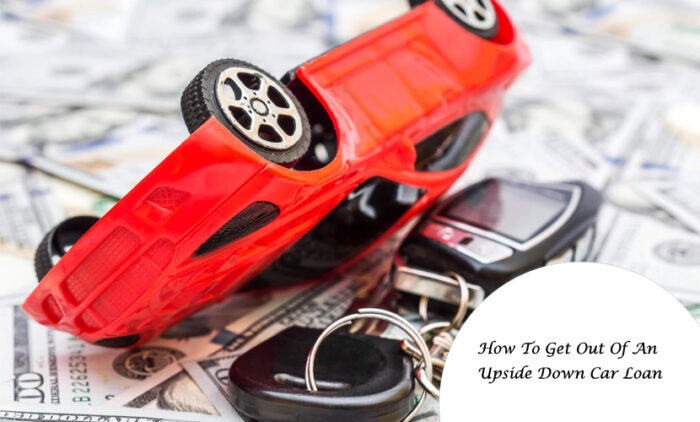How can I get out of an upside down car loan? Getting out of a situation where you owe more on your car loan than your car is worth can be tough. This is called negative equity, or an upside-down car loan.

It happens because your car’s value drops faster than you can pay off the loan, or you got a high-interest rate, or a long loan term. Being in this spot can make it hard to sell or trade your car without losing money.
To fix this problem, you need to find ways to deal with your upside-down car loan. Learn about your options and take action to get back on track with your car finances.
How To Determine If Your Car Loan Has Negative Equity
To check if your car loan is upside-down, follow these steps:
First, figure out the negative equity. Compare how much you owe on your car loan to how much your car is worth now. You can use trusted sources like Kelley Blue Book or Edmunds to estimate your car’s value based on its model, year, condition, and mileage.
Then, check your loan balance. Contact your lender or look at your loan statement to see exactly how much you still owe. Remember, this amount changes because of daily interest.
Finally, compare your car’s value with your loan balance. If your car is worth less than what you owe, it means you’re probably upside-down on your loan. Doing this will help you understand how much negative equity you have and see where you stand financially.
How To Get Out Of An Upside-Down Car Loan
As earlier stated, getting out of an upside-down car loan can be pretty challenging, but it is not impossible. Here are some simple steps you can follow if you find yourself in such a situation.
- Calculate the negative equity.
- Pay off your loan faster.
- Refinance your loan.
- Sell your car.
Calculate Negative Equity
Determine the difference between the value of your car and the amount you owe by using industry guides like Kelley Blue Book or Edmunds. This will help you understand the extent of your negative equity.
Pay Off Your Loan Faster
Consider making extra payments towards your loan to accelerate the repayment process. This can save you money on interest and help you get out of the negative equity situation sooner.
Refinance Your Loan
If you can’t pay off the loan faster, refinancing is an option. This involves taking out a new loan with better terms and lower interest rates to make repayment more manageable. Although it won’t eliminate the negative equity
Sell Your Car
Selling the vehicle is another strategy. If you can cover both the loan balance and the negative equity from the sale proceeds, this can help you escape the upside-down car loan situation.
Tips For Avoiding An Upside-Down Car Loan
To avoid ending up with an upside-down car loan, consider the following tips:
Increase Your Down Payment
Offer a larger down payment, ideally at least 20% of the car’s value. This can reduce the amount you need to finance and help you stay right-side up on your loan.
Choose A Short Repayment Term
Opt for a loan term of no longer than four years to avoid negative equity. A shorter loan duration means paying less in interest over time and paying off the loan more quickly.
Avoid Unnecessary Add-Ons
Refrain from accepting unnecessary add-ons like extended warranties that can inflate your loan beyond the car’s value. Carefully review the loan agreement and opt out of add-ons that are not essential.
Shop Around for Rates
Compare interest rates, terms, amounts, and fees from different lenders before finalizing a loan. Obtaining preapproval from multiple lenders can help secure the lowest APR and save money on the loan.
Buy a Used Car
Consider purchasing a used car instead of a new one, as they are more affordable and tend to hold their value better, reducing the risk of negative equity.
By following these tips, you can minimize the risk of ending up with an upside-down car loan and ensure a more financially secure vehicle purchase.
Frequently Asked Questions
What Does It Mean To Be Upside Down On A Car Loan?
Being upside down on a car loan, also known as having negative equity, occurs when you owe more on the loan than the vehicle is worth.
This situation can arise due to factors like rapid depreciation of the car’s value and high loan amounts compared to the vehicle’s worth.
What Are The Consequences Of Defaulting On An Upside-Down Car Loan?
Defaulting on an upside-down car loan can have serious repercussions, including damage to your credit score and making it more challenging to secure future auto loans.
However, it’s important to explore options like refinancing, making extra payments, or selling the vehicle to effectively address negative equity.
Is Surrendering The Vehicle A Viable Option For Dealing With An Upside-Down Car Loan?
Surrendering the vehicle to the lender can be an option to address the loan, but it should be considered as a last resort.
Voluntary surrender may be preferable to repossession, as repossession can lead to legal consequences and negatively impact your credit score.
What Are The Advantages Of Paying Off An Upside-Down Car Loan Early?
Paying off your loan early can help you save money on interest payments over time and reduce the overall cost of the loan.
It can also enable you to regain equity in the vehicle faster and potentially improve your financial standing.
What Should I Do If I Can’t Afford To Pay Off My Upside-Down Car Loan?
If you’re struggling to afford payments on the loan, consider reaching out to your lender to discuss potential options such as restructuring the loan, deferring payments, or exploring hardship programs. It’s important to communicate proactively to avoid defaulting on the loan.



